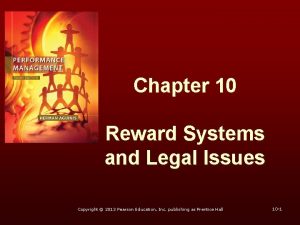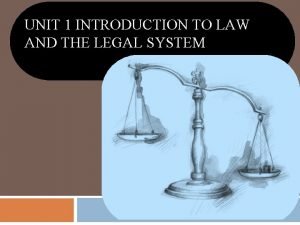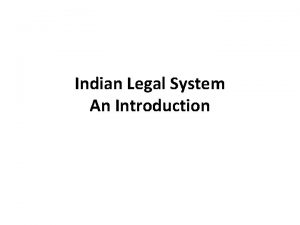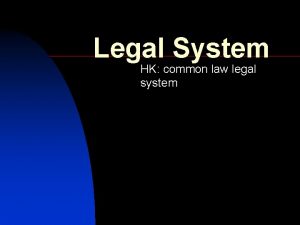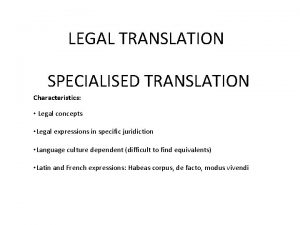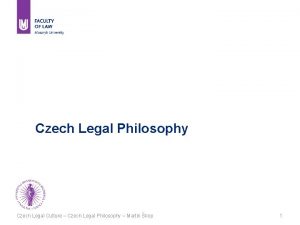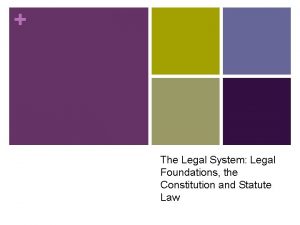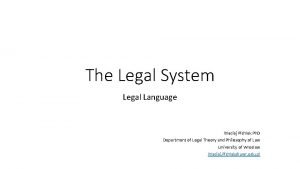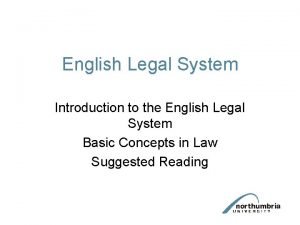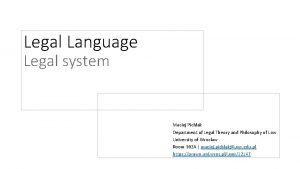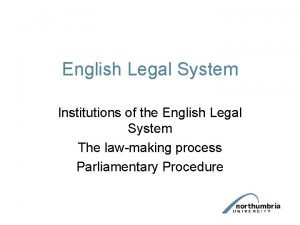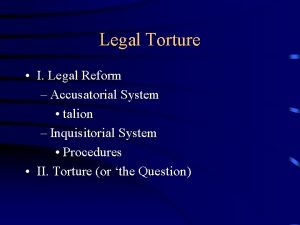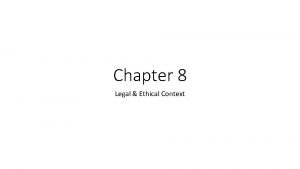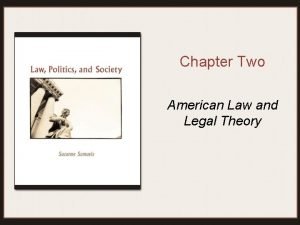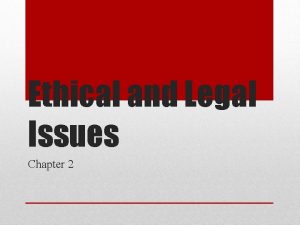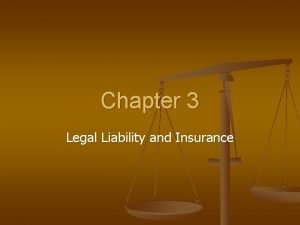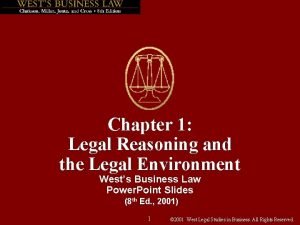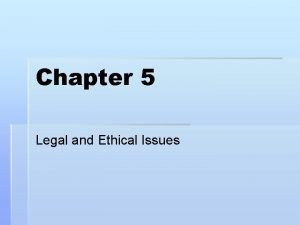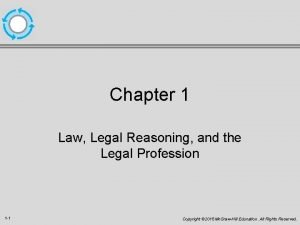Chapter 3 The U S Legal System and


































- Slides: 34

Chapter 3 The U. S. Legal System and Alternative Dispute Resolution © 2019 Mc. Graw-Hill Education. All rights reserved. Authorized only for instructor use in the classroom. No reproduction or further distribution permitted without the prior written consent of Mc. Graw-Hill Education. 1

Types of Jurisdiction 1 • Original Jurisdiction: The power to hear and decide cases when they first enter the legal system. • Appellate Jurisdiction: The power to review previous judicial decisions to determine whether trial courts erred in their decisions. © 2019 Mc. Graw-Hill Education. 2

Types of Jurisdiction 2 • In personam jurisdiction: The power to render a decision affecting the rights of the specific persons before the court. • Subject-matter jurisdiction: The power to hear certain kinds of cases. © 2019 Mc. Graw-Hill Education. 3

Subject-Matter Jurisdiction: Exclusive Federal Jurisdiction • Admiralty cases. • Bankruptcy cases. • Federal criminal prosecutions. • Cases in which one state sues another state. • Claims against the United States. • Other claims involving federal statutes that specify exclusive federal jurisdiction. © 2019 Mc. Graw-Hill Education. 4

Subject-Matter Jurisdiction: State Jurisdiction • All cases not falling under Exclusive Federal Jurisdiction. © 2019 Mc. Graw-Hill Education. 5

Subject-Matter Jurisdiction: Concurrent Federal and State Jurisdiction • Federal question cases. • Diversity of citizenship cases. © 2019 Mc. Graw-Hill Education. 6

The Federal Court System • The United States Supreme Court. • Intermediate Courts of Appeal. • Federal Trial Courts (U. S. District Courts). © 2019 Mc. Graw-Hill Education. 7

State Court Systems • State Supreme Courts. • Intermediate Courts of Appeal. • State Trial Courts. © 2019 Mc. Graw-Hill Education. 8

Threshold Requirements for Litigation Standing (to sue) • Actual/imminent injury in fact. • Injury traceable to actions of defendant. • Injury redressed by favorable decision. Case or Controversy (Justifiable Controversy) • Adverse relationship between plaintiff and defendant. • Actions of one party give rise to legal dispute. • Court decision able to resolve dispute. Ripeness • Decision able to affect parties immediately. © 2019 Mc. Graw-Hill Education. 9

Jurisdiction vs. Venue Jurisdiction Venue • The power of a court to hear a case. • The most appropriate geographical location where a case should be heard. It is usually where the parties reside or where the case allegedly arose. © 2019 Mc. Graw-Hill Education. 10

Steps in Civil Litigation: The Pretrial Stage • Informal Negotiations. • Pleadings. • Service of Process. • Defendant’s Response. • Pretrial Motions. • Discovery. • Pretrial Conference. © 2019 Mc. Graw-Hill Education. 11

Steps in Civil Litigation: The Trial • Jury Selection. • Opening Statements. • Examination of Witnesses and Presentation of Evidence. • Closing Arguments. • Jury Instructions. © 2019 Mc. Graw-Hill Education. 12

Discovery • Discovery occurs after the pleadings (Complaint, Answer, Counter-claim, Cross-claim, Response) have been filed. • Discovery is the exchange of relevant documents and evidence by the parties. • Discover devices include interrogatories, requests to produce documents, depositions and requests for admission of facts. © 2019 Mc. Graw-Hill Education. 13

Pre-trial and Post-trial Motions Pre-trial Post-trial • Motion for judgment in accordance with verdict. • Demurrer/Motion to dismiss for failure to state a claim. • Motion for judgment on the pleadings. • Motion for summary judgment. • At trial – Motion for a directed verdict. • Motion for judgment notwithstanding of verdict (judgment n. o. v. ). Called a motion for judgment as a matter of law in federal court. • Motion for a new trial. © 2019 Mc. Graw-Hill Education. 14

Steps in Civil Litigation: Appellate Procedure © 2019 Mc. Graw-Hill Education. 15

Appeal • A prejudicial error of law must exist for an appeal to succeed. • Appeals are only on the record. No additional evidence can be considered by the appellate court. • For most cases only one appeal to an intermediate court of appeal is allowed. © 2019 Mc. Graw-Hill Education. 16

Appellate Court Decision-Making Powers • Affirmation. • Modification. • Reversal. • Remand. © 2019 Mc. Graw-Hill Education. 17

Appeal to the U. S. Supreme Court • The U. S. Supreme Court hears very few cases. • At least four justices must agree to grant a Writ of Certiorari for the Court to hear a case. © 2019 Mc. Graw-Hill Education. 18

Alternative Dispute Resolution 1 © 2019 Mc. Graw-Hill Education. 19

Alternative Dispute Resolution 2 • Definition: The resolution of legal disputes through methods other than litigation, such as negotiation, mediation, arbitration, summary jury trials, mini-trials, neutral case evaluations, and private trials. © 2019 Mc. Graw-Hill Education. 20

Reasons A Business Might Prefer Alternative Dispute Resolution (ADR) Versus Litigation • ADR methods are generally faster and less expensive than litigation. • Business may wish to avoid uncertainty associated with a jury decision. • Business may wish to avoid setting precedent through court decision. • Business may prefer confidential nature of ADR. • Compared to litigation, ADR might better allow parties to preserve business relationship. © 2019 Mc. Graw-Hill Education. 21

Primary Forms of Alternative Dispute Resolution • Negotiation. • Mediation. • Arbitration. © 2019 Mc. Graw-Hill Education. 22

Advantages of Mediation • Helps disputing parties preserve their professional relationships. • Provides possibility of finding creative solutions to dispute. • Offers participants high level of autonomy. © 2019 Mc. Graw-Hill Education. 23

Disadvantages of Mediation • Appears to be an equal process and solution, thereby hiding power imbalances that would lead to the party with greater power securing an agreement of greater benefit. • Some enter mediation with no intention of finding a solution, and use mediation as a delay tactic. © 2019 Mc. Graw-Hill Education. 24

Advantages of Arbitration • More efficient and less expensive than litigation. • Parties have more control over the process of dispute resolution (parties choose the arbitrator and determine how formal the process will be). • Parties can choose arbitrator with expertise in specific subject matter of dispute. • Arbitrator has greater flexibility in decisionmaking (compared to decision-making authority of judge). © 2019 Mc. Graw-Hill Education. 25

Disadvantages of Arbitration • As use of arbitration increases, efficiencies and lower cost advantages (compared to litigation) decrease. • Difficulty of appealing an arbitration award. • Loss of civil rights and remedies available through litigation. • Companies and employers may effectively “hide” their disputes through arbitration (non-public nature of arbitration versus public trial). © 2019 Mc. Graw-Hill Education. 26

Binding Arbitration Clause • Definition: A provision in a contract mandating that all disputes arising under a contract must be settled by arbitration. © 2019 Mc. Graw-Hill Education. 27

Tips for Creating a Binding Arbitration Clause • Identify what you wish to arbitrate. • Make arbitration clause bilateral. • State which party will pay arbitrator’s fees. • Ensure arbitration is cost-effective (compared to litigation). • Specify how arbitrator selected. • Identify arbitration costs. • Avoid limitations on remedies. • Consider other parties when determining where to hold arbitration. © 2019 Mc. Graw-Hill Education. 28

Other Alternative Dispute Resolution Methods • Mediation-Arbitration (“Med-Arb”). • Summary Jury Trial. • Mini-Trial. • Early Neutral Case Evaluation. • Private Trials. © 2019 Mc. Graw-Hill Education. 29

Case Hypothetical Discussion Questions © 2019 Mc. Graw-Hill Education. 30

Chapter 3 Case Hypothetical 1 Ted Henry, trial court administrator of the court system in Ticonderoga County, New York. He has grown tired of the relatively trivial cases plaguing his county’s court docket. Ted thinks everyone wants to sue these days, even when the amount in controversy is trivial. The number of cases in the county with less than $10, 000 in controversy has doubled in the past ten (10) years. Ticonderoga County’s financial resources are limited. For Ted personally, it has become challenging to manage the trial court docket each week with only a limited number of judges, bailiffs, trial transcriptionists, and other key court personnel available. Ted knows that time is definitely money. He knows too that local taxpayers oppose the hiring of more judges and other court personnel to respond to the onslaught of increased litigation. © 2019 Mc. Graw-Hill Education. 31

Chapter 3 Case Hypothetical 2 Ted has a modest proposal. He would like to implement binding arbitration for all cases involving an amount in controversy of less than $10, 000. The parties involved in the litigation would pay for the expenses of arbitration, and select the arbitrator. Ted’s proposal would reduce the number of cases and save the county money. © 2019 Mc. Graw-Hill Education. 32

Chapter 3 Case Hypothetical 3 Ted is excited about his proposal, since (if implemented) it would reduce dramatically the number of cases processed through the judicial system, thereby saving the taxpayers money, and making his job easier. • Is Ted Henry’s proposal, for binding arbitration in all civil cases involving less than $10, 000 in controversy, legal? • Is it ethical? © 2019 Mc. Graw-Hill Education. 33

Chapter 3 Discussion Question The Consumer Financial Protection Bureau has been considering adoption of a rule that makes it easier for consumers to bring class action lawsuits against financial companies by banning arbitration clauses written in the fine print of consumer financial services contracts. Is this a good idea? Discuss the pros and cons of the proposed rule. © 2019 Mc. Graw-Hill Education. 34
 Reward system and legal issues
Reward system and legal issues Unit 1 introduction to law and the legal system
Unit 1 introduction to law and the legal system Hát kết hợp bộ gõ cơ thể
Hát kết hợp bộ gõ cơ thể Ng-html
Ng-html Bổ thể
Bổ thể Tỉ lệ cơ thể trẻ em
Tỉ lệ cơ thể trẻ em Voi kéo gỗ như thế nào
Voi kéo gỗ như thế nào Chụp tư thế worms-breton
Chụp tư thế worms-breton Chúa yêu trần thế
Chúa yêu trần thế Kể tên các môn thể thao
Kể tên các môn thể thao Thế nào là hệ số cao nhất
Thế nào là hệ số cao nhất Các châu lục và đại dương trên thế giới
Các châu lục và đại dương trên thế giới Công của trọng lực
Công của trọng lực Trời xanh đây là của chúng ta thể thơ
Trời xanh đây là của chúng ta thể thơ Mật thư anh em như thể tay chân
Mật thư anh em như thể tay chân Phép trừ bù
Phép trừ bù độ dài liên kết
độ dài liên kết Các châu lục và đại dương trên thế giới
Các châu lục và đại dương trên thế giới Thơ thất ngôn tứ tuyệt đường luật
Thơ thất ngôn tứ tuyệt đường luật Quá trình desamine hóa có thể tạo ra
Quá trình desamine hóa có thể tạo ra Một số thể thơ truyền thống
Một số thể thơ truyền thống Cái miệng xinh xinh thế chỉ nói điều hay thôi
Cái miệng xinh xinh thế chỉ nói điều hay thôi Vẽ hình chiếu vuông góc của vật thể sau
Vẽ hình chiếu vuông góc của vật thể sau Thế nào là sự mỏi cơ
Thế nào là sự mỏi cơ đặc điểm cơ thể của người tối cổ
đặc điểm cơ thể của người tối cổ Ví dụ giọng cùng tên
Ví dụ giọng cùng tên Vẽ hình chiếu đứng bằng cạnh của vật thể
Vẽ hình chiếu đứng bằng cạnh của vật thể Fecboak
Fecboak Thẻ vin
Thẻ vin đại từ thay thế
đại từ thay thế điện thế nghỉ
điện thế nghỉ Tư thế ngồi viết
Tư thế ngồi viết Diễn thế sinh thái là
Diễn thế sinh thái là Các loại đột biến cấu trúc nhiễm sắc thể
Các loại đột biến cấu trúc nhiễm sắc thể Các số nguyên tố là gì
Các số nguyên tố là gì
